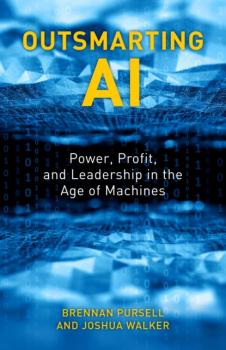Банковское дело
Различные книги в жанре Банковское делоEngine of Inequality
The first book to reveal how the Federal Reserve holds the key to making us more economically equal, written by an author with unparalleled expertise in the real world of financial policy Following the 2008 financial crisis, the Federal Reserve’s monetary policy placed much greater focus on stabilizing the market than on helping struggling Americans. As a result, the richest Americans got a lot richer while the middle class shrank and economic and wealth inequality skyrocketed. In Engine of Inequality, Karen Petrou offers pragmatic solutions for creating more inclusive monetary policy and equality-enhancing financial regulation as quickly and painlessly as possible. Karen Petrou is a leading financial-policy analyst and consultant with unrivaled knowledge of what drives the decisions of federal officials and how big banks respond to financial policy in the real world. Instead of proposing legislation that would never pass Congress, the author provides an insider's look at politically plausible, high-impact financial policy fixes that will radically shift the equality balance. Offering an innovative, powerful, and highly practical solution for immediately turning around the enormous nationwide problem of economic inequality, this groundbreaking book: Presents practical ways America can and should tackle economic inequality with fast-acting results Provides revealing examples of exactly how bad economic inequality in America has become no matter how hard we all work Demonstrates that increasing inequality is disastrous for long-term economic growth, political action, and even personal happiness Explains why your bank's interest rates are still only a fraction of what they were even though the rich are getting richer than ever, faster than ever Reveals the dangers of FinTech and BigTech companies taking over banking Shows how Facebook wants to control even the dollars in your wallet Discusses who shares the blame for our economic inequality, including the Fed, regulators, Congress, and even economists Engine of Inequality: The Fed and the Future of Wealth in America should be required reading for leaders, policymakers, regulators, media professionals, and all Americans wanting to ensure that the nation’s financial policy will be a force for promoting economic equality.
Stick Together
Build a stronger team with this illustrated fable From bestselling author Jon Gordon and coauthor Kate Leavell, Stick Together delivers a crucial message about the power of belief, ownership, connection, love, inclusion, consistency, and hope. The authors guide individuals and teams on an inspiring journey to show them how to persevere through challenges, overcome obstacles, and create success together. Stick Together follows Coach David, a high school basketball coach looking to motivate his team for the new season. The team members are given sticks with words written on them and tasked with a number of missions: To find another player with the same word written on their stick To explain why that word is important for a team to be their best To render their sticks unbreakable As the players work together to complete their tasks, they discover how to make their team stronger and create an unbreakable bond. Perfect for student athletes and teams in all industries including business, education, healthcare, and nonprofit, and for readers of all ages, Stick Together will resonate with anyone looking to improve their team performance and excel in a group environment.
Introduction to Islamic Banking and Finance
This book, Introduction to Islamic Banking and Finance: An Economic Analysis, covers the basic principles of Islamic economics and finance. It discusses both the theory of Islamic economics and finance as well as the applications in the design of instruments of finance as well as Islamic financial institutions. The book enables its readers to gain an understanding of the structures and operations of Islamic banking, Islamic capital market investments, risk management, and taxation for Islamic banking contracts.The book sets forth the following objectives:<b>Contents:</b> <ul><li><b><i>Foundations of Islamic Finance:</i></b><ul><li>Introduction to Islamic Finance</li><li>Islamic View on Capital Allocation</li></ul></li><li><b><i>Theory and Application of Islamic Banking Products:</i></b><ul><li>Product Structures in Islamic Banking</li><li>Economics of Islamic Banking Product Structures</li></ul></li><li><b><i>Islamic Capital and Money Markets:</i></b><ul><li>Islamic Equity Investments</li><li><i>Sukuk</i> in Islamic Capital Markets</li><li>Islamic Money Market</li></ul></li><li><b><i>Risk Management in Islamic Finance:</i></b><ul><li><i>Takaful</i></li><li>Risk Management in Islamic Banks</li></ul></li><li><b><i>Islamic Banking: The Way Forward:</i></b><ul><li>Islamic Social Finance</li><li>Islamic Banking in the Digital Era</li><li>Mainstreaming Islamic Finance: The Way Forward</li></ul></li></ul><br><b>Readership:</b> University students and faculty members in the field of Islamic Banking and Finance, practitioners in the field of Islamic Banking and Islamic Finance. Islamic Banking;Islamic Finance;Participation Banking;Ethical Banking;Interest Free Banking;Socially Responsible Investments;Impact Investments0<b>Key Features:</b><ul><li>The book provides a global perspective on Islamic finance instruments</li><li>The book is beneficial to academicians, researchers, practitioners and legal experts who wish to get a global perspective on Islamic Banking and Finance products and their applications</li><li>The book gives a comparative analysis of accounting and risk framework for Islamic finance in diverse countries</li><li>The book is beneficial to be used in Islamic banking and finance courses in academia and executive learning programs which cover Islamic banking and finance practice</li></ul>
Мир который не изменить
Для того чтобы лучше узнать эту книгу предстоит прочитать то, что было написано в заголовке романа, описанного мною. В разделе, “Мира которого не изменить”. Однако, целью вступления, и аннотации, является донесением основной цели до читателя, что это, является мнением автора.В основном, речь идет от том, что это отношения героя к роману, где, сколько отношения играют роль, столько герой и мучается от своих проблем.Написанный текст доводит до читателя об отношениях и взаимодействиях сил властей и их собственной жизни.Главный герой нисколько не
Outsmarting AI
From factories to smartphones, Artificial Intelligence is already taking over. Outsmarting AI is not a how-to guide on making AI work, but making it work for YOU to boost profits and productivity. Each development in Artificial Intelligence (AI) technology brings about apprehension and panic for the future of society and for business. We’re bombarded with stories about the impending human-less workplace; it is no longer a question if man can be replaced by machine in certain tasks, but when. However, AI was not manufactured to destroy life as we know it. These emerging technologies were developed and are constantly updating with a particular goal in mind: optimization. AI feeds on data and information to improve outputs and increase potential. With this enhanced productivity, profit and productivity will be sure to follow.Written by Brennan Pursell, a business consultant and professor who hates jargon, and Joshua Walker, an AI pioneer with 18 years of experience in solutions and applications, Outsmarting AI is the first plain-English how-to guide on adapting AI for the non-coding proficient business leader. This book will help readers to Cut through the fog of AI hype See exactly what AI can actually do for people in business Identify the areas of their organization in most need of AI tools Prepare and control their data – AI is useless without it Adopt AI and develop the right culture to support it Track the productivity boost, cost savings, and increased profits Manage and minimize the threat of crippling lawsuits
Ultimate Price
How much is a human life worth? Individuals, families, companies, and governments routinely place a price on human life. The calculations that underlie these price tags are often buried in technical language, yet they influence our economy, laws, behaviors, policies, health, and safety. These price tags are often unfair, infused as they are with gender, racial, national, and cultural biases that often result in valuing the lives of the young more than the old, the rich more than the poor, whites more than blacks, Americans more than foreigners, and relatives more than strangers. This is critical since undervalued lives are left less-protected and more exposed to risk.Howard Steven Friedman explains in simple terms how economists and data scientists at corporations, regulatory agencies, and insurance companies develop and use these price tags and points a spotlight at their logical flaws and limitations. He then forcefully argues against the rampant unfairness in the system. Readers will be enlightened, shocked, and, ultimately, empowered to confront the price tags we assign to human lives and understand why such calculations matter.
The American Title Insurance Industry
After World War II, banks and other mortgage lenders began requiring insurance to protect them against flawed or defective real estate titles. Over the past sixty years, the title insurance industry has grown steadily in size, power, and secrecy: policies are available for both lenders and property owners and many title insurers offer an array of other real estate services, such as escrow and appraisal. Yet details about the industry’s operational procedures remain closely guarded from public exposure.In The American Title Insurance Industry , Joseph and David Eaton present evidence that improvements in recordkeeping over the last sixty years—particularly the advent of computers—have reduced the likelihood of a defective title going unnoticed in a property transaction. But the industry’s flaws run deeper than mere obsolescence: in most states, title insurers are allowed to engage in anticompetitive business practices, including price-fixing. Among the findings in this meticulously researched study are instances of insurers charging premiums well above the amount necessary to compensate them for assuming the risk of defect and identical policies with identical risk that vary in price by hundreds of percentage points for different geographic locations. The authors also examine the widely ignored role that the federal and most state governments play in perpetuating the title insurance industry’s unfair practices. Whereas most private industries prefer as little government intervention as possible, title insurers welcome it. Federal statue exempts title insurers from anti-trust liability, opening the door for price-fixing and destroying any semblance of free-market competition or market power for consumers. A landmark study for elected officials, and all those involved in the insurance, real estate, and brokerage industries, The American Title Insurance Industry brings to light a long-neglected problem—and offers suggestions for how it might be remedied.









